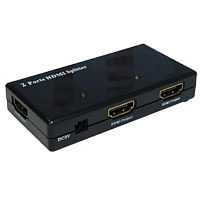An HDMI splitter is a device that splits an HDMI signal to multiple displays, sometimes called an HDMI Distribution Amplifer. Suppose you wanted to watch Sky HD on 2 TVs, an HDMI splitter could be used to duplicate the input and give 2 identical outputs. The number of outputs provided is referred to as ports or ways, you may see the item described as a 2 port or 2 way if it has 2 outputs. A typical 2 port splitter shown below will cost around £40.
